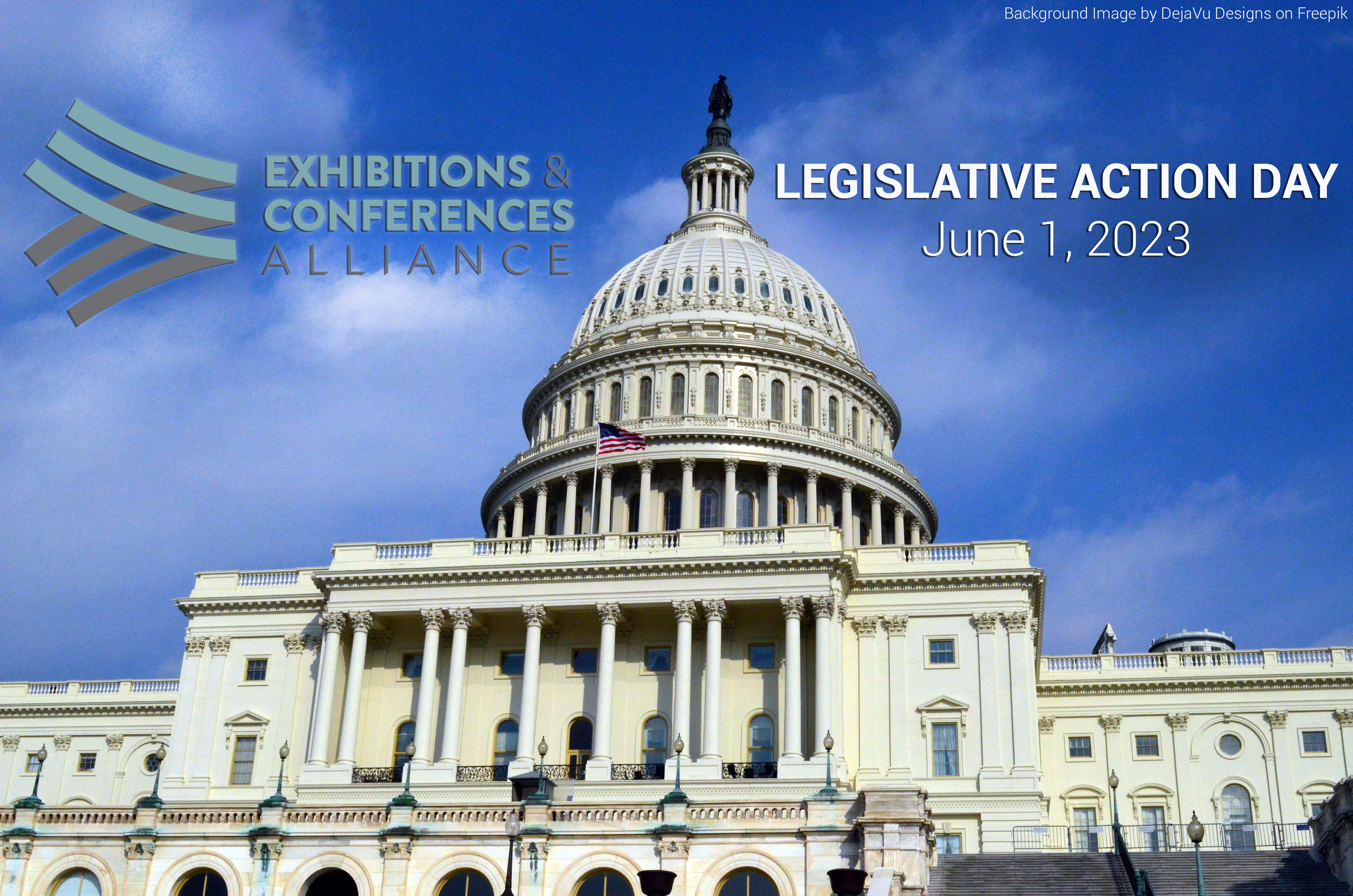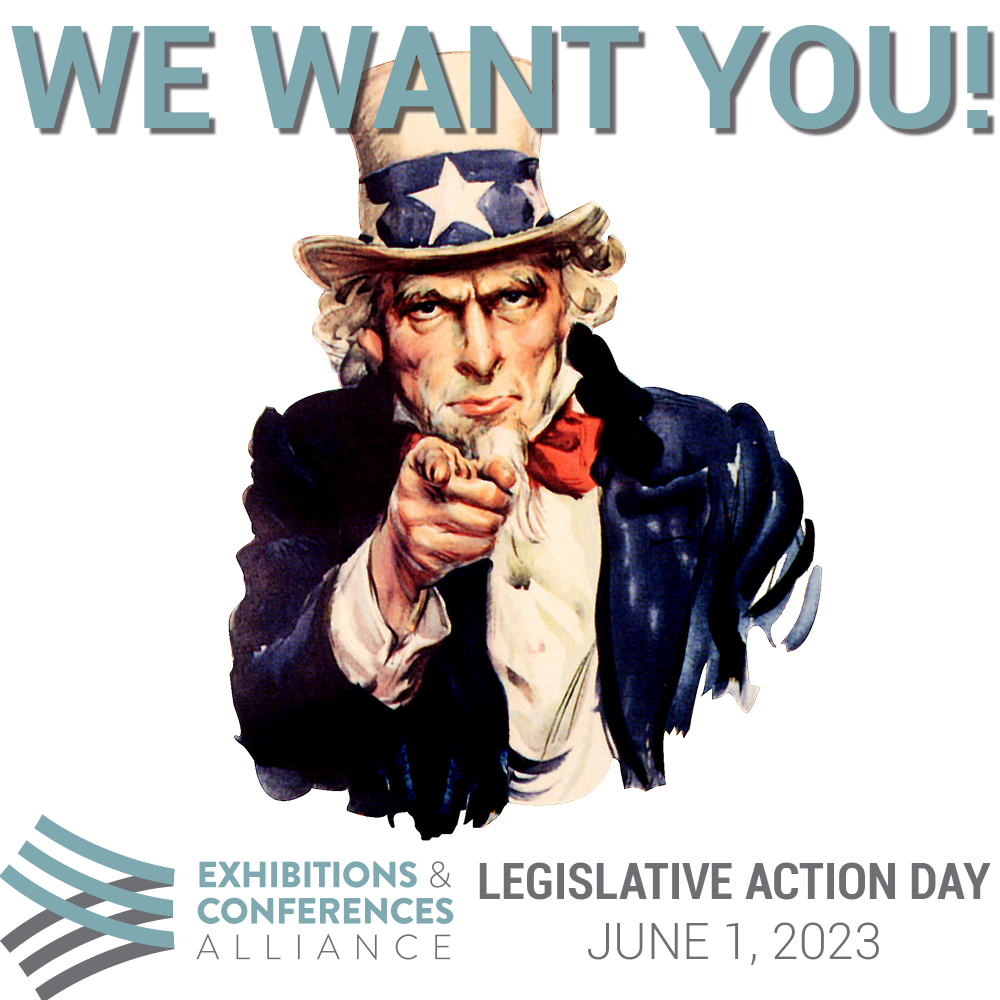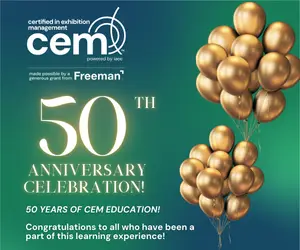By Mary Tucker, IAEE Sr. Communications & Content Manager

Legislative Action Day on 1 June 2023 will provide professionals in the exhibitions and events industry the opportunity to meet face-to-face with U.S. lawmakers to persuade them to help maximize our recovery by supporting the industry’s policy priorities.
Established in 2014 as IAEE Exhibitions Day, this advocacy initiative evolved from a once-a-year event to a full-time operation with the formation of the Exhibitions and Conferences Alliance (ECA) in 2021. The ECA is dedicated to the advancement of the face-to-face business events industry, and represents a coalition comprising major industry organizations.
IAEE recently spoke with ECA Vice President of Government Affairs Tommy Goodwin, who leads the industry’s efforts in Washington, D.C., about the issues that will be presented at this year’s Legislative Action Day and what attendees can look forward to. As one would expect from one of the nation’s top lobbyists, Goodwin provides a thorough breakdown of the issues participants will be addressing.
Fix Visa Wait Times
It’s no secret that one of the most brutal obstacles the industry currently faces is the wait times for business travel visas issued abroad. In some countries, it surpasses a year. The norm for many countries is not far behind and in the trade show world, that simply doesn’t work.
“What we are trying to do is get back to a standard that was established under the Obama administration, where 80 percent of all U.S. visas are issued within 21 days,” explains Goodwin. “That’s the gold standard.”
Some markets are already there, but they tend to represent smaller segments or reside in places that don’t have a lot of visitors. Business-to-business (B2B) event professionals in countries like India, Mexico, Brazil, China and Columbia experience difficulty because those areas are still operating much like in the times of COVID when the U.S. was under a travel ban. The U.S. travel ban was lifted in November of 2021, but for many of these countries the visa delays mean that the ban basically remains in effect.
In the simplest of terms, attendees and exhibitors are not able to come back to U.S. events – and this is a real problem. The Center for Exhibition Industry Research (CEIR) reports that each exhibitor that comes to the U.S. generates the equivalent of $36K toward the U.S. economy. Take that away and there is significant economic impact being left on the table.
CEIR is also projecting a full recovery for the industry in 2024; roughly 20 percent of what we’re lacking to meet that goal comes from the international audience that currently cannot attend events due to visa wait times. As such, the ECA is making this issue a top priority through these two action items:
Asking Congress to amplify its oversight over the State Department.
U.S. embassies and consulates abroad fall under the umbrella of the U.S. State Department. Consulates manage the interviews, country by country, under the auspices of U.S. laws using processes led out of those embassies. However, since each consulate is fairly autonomous, there is a tremendous loss of consistency that could be remedied with a standard procedure that resolves the disparate wait times we currently experience among certain regions. Goodwin says it comes down to staffing and operations:
“One of the challenges we are hearing is that the staffing levels and processes are so different depending on which embassy or consulate you are applying at, that they can even differ within the same country.
“Some areas do very well because they are throwing everything they can at it including more people, more funding, moving people around, staying open weekends – anything that will work. How do we take that level of excellence, surface it and make it the standard across the board?”
For example, there was a period of time in Mexico in which consulates stayed open on weekends to process visas resulting in capacity increases of 40 percent. Once the expanded schedule stopped, the numbers went back down. These staffing and operations success stories offer opportunities for standardization.
Part of the overall challenge encompasses processes and U.S. law, and part of it requires capitalizing on proven positive results. Why are some cities within a country doing better than others? We need to understand and use this information to create a set of best practices.
Asking Congress to support a bill from the Senate proposing updated visa processes that get us back to the gold standard.
This legislation is under development but proposes efficiencies like video visa interviews and batch processing for B2B events. The ECA will be asking that wait times be reduced and, equally important, that other safeguards be implemented to make sure this never happens again – pandemic or otherwise. Solutions such as new laws, authorizations, applications of biometric and security technologies need to be implemented by the State Department expeditiously.
“We would love to see a situation in which an event organizer collects all of its international attendee information four to six months in advance of the event and shoots it over to the State Department so that attendees don’t have to complete one-off interviews throughout all the individual embassies,” notes Goodwin. “How can the State Department process these in bulk? Our leaders recognize that these are business visitors coming to the U.S. to contribute to our economy. How do we roll out the red carpet for them instead of building a wall?”
Improve Aid for Workforce Development
There are essentially two openings for every job seeker right now due to the fact that when exhibitions and events nearly shut down completely, it lost some of its most experienced members to other industries. While the industry has been striving to replace these roles and/or transition workers from junior roles, it leaves a formidable gap in the workforce funnel regarding entry-level employees. How do we attract new talent to the industry and move them through the learning process so they can build their career like their predecessors?
The federal government can support education and training programs that can help industries like ours advance. The government offers significant funding for colleges and universities in the form of student loans, grants and other support programs. It also supports K-12 student education via block grants and curriculum establishments. In addition, it provides many training programs. However, most of these aids were designed with four-year colleges in mind.
In our industry, workers may enter through degreed programs such as accounting, business, IT, etc. but there are also plenty of entry opportunities through skilled trades such as booth builders, electricians, contractors and organized labor. This is where the disconnect occurs. For example, you can use a Pell grant for either a community college or four-year degree program but you can’t use it for a trade school, apprenticeship program or certification program.
“If we have these skilled labor gaps and are looking for people to fill these positions, we need Congress to re-write these limiting rules so that we can make this happen,” says Goodwin. “And that’s just one example, there are many more ways to help. How do we help create additional pathways into the industry for those not coming from four-year colleges, such as our skilled laborers that are essential to our industry?”
Even technology-based positions may experience this disadvantage. Our industry has become so tech-forward that many workers aren’t willing to wait four years to enter the workforce. Another compelling argument is that this industry offers newcomers solid middle-class starting wages. It’s not uncommon for young professionals to stay through retirement because that’s how lucrative this industry can be, and we need to be able to communicate and facilitate that for our younger workforce.
“This is all very attractive to government, but it needs our help in getting out of its own way and smoothing the path for progress,” notes Goodwin. “The challenge lies in that our government is behind in reauthorizing these laws by several years, so we need to create an environment politically that pushes it along.”
The Good News
Goodwin is quick to point out that Congress understands the industry much better than it did in 2014 and we have made significant headway in the transition from the once-a-year effort to a year-round campaign.
“It is our responsibility as an industry to continue the process year-long. To join our voices on one day is an effective expression and reminder to our leaders,” he states. “But in our government, the squeaky wheel gets the grease and the ECA serves as that squeaky wheel.
“Effectively, our leaders understand the loss we’ve suffered and that we are still on a journey to recovery. I believe participants at this year’s event will appreciate the reception and familiarity they will get – particularly toward the issues we’re presenting – because nobody has to be told in their Congressional offices that we need support. These issues are front and center because of our ongoing efforts and we are making a much deeper impact.”
Be the Voice
Goodwin adamantly stresses the importance of having the “real voices of this industry” on Capitol Hill telling their story because a lobbyist can educate U.S. leaders on the great work you do, but it means much more coming from their constituents.
“We want the voices of those who have done this many times as well as newcomers,” he states. “Do not be intimidated by the process, we will walk you through every bit of it. We will provide quick and simple, pre-recorded webinars to prepare you beforehand. We schedule the meetings, we provide the policy briefings, we bus you around, we celebrate you afterwards! Even if you arrive a novice, you will leave a bonified industry advocate.”


